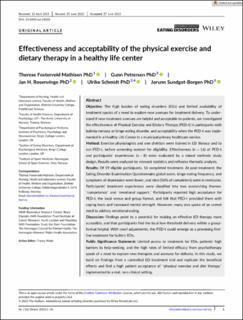| dc.contributor.author | Mathisen, Therese Fostervold | |
| dc.contributor.author | Pettersen, Gunn | |
| dc.contributor.author | Rosenvinge, Jan H. | |
| dc.contributor.author | Schmidt, Ulrike | |
| dc.contributor.author | Sundgot-Borgen, Jorunn | |
| dc.date.accessioned | 2023-07-25T20:01:32Z | |
| dc.date.available | 2023-07-25T20:01:32Z | |
| dc.date.created | 2023-07-18T07:09:07Z | |
| dc.date.issued | 2023 | |
| dc.identifier.citation | International Journal of Eating Disorders. 2023. | en_US |
| dc.identifier.issn | 0276-3478 | |
| dc.identifier.uri | https://hdl.handle.net/11250/3081374 | |
| dc.description.abstract | Objective: The high burden of eating disorders (EDs) and limited availability of treatment speaks of a need to explore new avenues for treatment delivery. To understand if new treatment avenues are helpful and acceptable to patients, we investigated the effectiveness of Physical Exercise and Dietary Therapy (PED-t) in participants with bulimia nervosa or binge-eating disorder, and acceptability when the PED-t was implemented in a Healthy Life Center in a municipal primary healthcare service. Method: Exercise physiologists and one dietitian were trained in ED literacy and to run PED-t, before screening women for eligibility. Effectiveness (n = 16) of PED-t and participants' experiences (n = 8) were evaluated by a mixed methods study design. Results were analyzed by relevant statistics and reflexive thematic analysis. Results: Of 19 eligible participants, 16 completed treatment. At post-treatment, the Eating Disorder Examination Questionnaire global score, binge-eating frequency, and symptoms of depression were lower, and nine (56% of completers) were in remission. Participants' treatment experiences were classified into two overarching themes: “competence” and “emotional support.” Participants reported high acceptance for PED-t, the local venue and group format, and felt that PED-t provided them with coping tools and increased mental strength. However, many also spoke of an unmet need to address emotional eating. Discussion: Findings point to a potential for making an effective ED therapy more accessible, and that participants find the local low-threshold delivery within a groupformat helpful. With small adjustments, the PED-t could emerge as a promising firstline treatment for bulimic EDs. Public Significance Statement: Limited access to treatment for EDs, patients' high barriers to help-seeking, and the high rates of limited efficacy from psychotherapy speak of a need to explore new therapies and avenues for delivery. In this study, we build on findings from a controlled ED treatment trial and replicate the beneficial effects and find a high patient acceptance of “physical exercise and diet therapy” implemented in a real, non-clinical setting. | en_US |
| dc.language.iso | eng | en_US |
| dc.publisher | Wiley | en_US |
| dc.relation.uri | https://onlinelibrary.wiley.com/doi/full/10.1002/eat.24020 | |
| dc.rights | Navngivelse 4.0 Internasjonal | * |
| dc.rights.uri | http://creativecommons.org/licenses/by/4.0/deed.no | * |
| dc.subject | acceptability | en_US |
| dc.subject | dietary therapy | en_US |
| dc.subject | eating disorders | en_US |
| dc.subject | effectiveness | en_US |
| dc.subject | healthy life center | en_US |
| dc.subject | exercise therapy | en_US |
| dc.subject | experiences | en_US |
| dc.subject | implementation | en_US |
| dc.subject | physical activity | en_US |
| dc.subject | treatment access | en_US |
| dc.title | Effectiveness and acceptability of the physical exercise and dietary therapy in a healthy life center | en_US |
| dc.type | Peer reviewed | en_US |
| dc.type | Journal article | en_US |
| dc.description.version | publishedVersion | en_US |
| dc.subject.nsi | VDP::Medisinske Fag: 700::Helsefag: 800::Andre helsefag: 829 | en_US |
| dc.source.journal | International Journal of Eating Disorders | en_US |
| dc.identifier.doi | 10.1002/eat.24020 | |
| dc.identifier.cristin | 2162637 | |
| cristin.ispublished | true | |
| cristin.fulltext | original | |
| cristin.qualitycode | 2 | |

